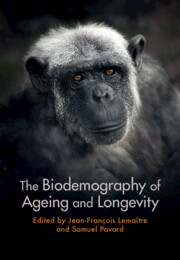Book contents
- The Biodemography of Ageing and Longevity
- The Biodemography of Ageing and Longevity
- Copyright page
- Dedication
- Contents
- Contributors
- Foreword
- Acknowledgements
- 1 The Eternal Youth of Ageing Research
- 2 Theories of Ageing across Ages
- 3 The Diversity of Longevity Metrics
- 4 The Meaning of ‘Exceptional Longevity’
- 5 The Inevitability of Senescence
- 6 The Untapped Potential of Zoo and Aquarium Data for the Comparative Biology of Ageing
- 7 Perspectives in Comparative Biology of Ageing
- 8 An Integrative Approach to Understanding Variation in the Form, Pattern and Pace of Ageing
- 9 Sex Differences in Lifespan, Ageing and Health in the Living World
- 10 Evolution of Human Reproduction, Ageing and Longevity
- 11 Lifespan and Mortality in Hunter-Gatherer and Other Subsistence Populations
- 12 Longevity in Modern Populations
- 13 Health Transition and Population Ageing
- 14 Limit of Human Longevity
- 15 Mortality Modelling at the Oldest Ages in Human Populations
- 16 Lessons from Exceptionally Long-Lived Individuals and Long-Living Families
- 17 Human Populations with Extreme Longevities
- 18 Socio-Economic Consequences of Increased Longevity in Contemporary Populations
- Index
- References
16 - Lessons from Exceptionally Long-Lived Individuals and Long-Living Families
Implications for Medical Research on Ageing and Age-Related Diseases
Published online by Cambridge University Press: 14 November 2024
- The Biodemography of Ageing and Longevity
- The Biodemography of Ageing and Longevity
- Copyright page
- Dedication
- Contents
- Contributors
- Foreword
- Acknowledgements
- 1 The Eternal Youth of Ageing Research
- 2 Theories of Ageing across Ages
- 3 The Diversity of Longevity Metrics
- 4 The Meaning of ‘Exceptional Longevity’
- 5 The Inevitability of Senescence
- 6 The Untapped Potential of Zoo and Aquarium Data for the Comparative Biology of Ageing
- 7 Perspectives in Comparative Biology of Ageing
- 8 An Integrative Approach to Understanding Variation in the Form, Pattern and Pace of Ageing
- 9 Sex Differences in Lifespan, Ageing and Health in the Living World
- 10 Evolution of Human Reproduction, Ageing and Longevity
- 11 Lifespan and Mortality in Hunter-Gatherer and Other Subsistence Populations
- 12 Longevity in Modern Populations
- 13 Health Transition and Population Ageing
- 14 Limit of Human Longevity
- 15 Mortality Modelling at the Oldest Ages in Human Populations
- 16 Lessons from Exceptionally Long-Lived Individuals and Long-Living Families
- 17 Human Populations with Extreme Longevities
- 18 Socio-Economic Consequences of Increased Longevity in Contemporary Populations
- Index
- References
Summary
This chapter presents how scientists currently use the increasing number of individuals who live to an age above 90 years (i.e. long-lived individuals) to investigate biological determinants of longevity. It will provide an overview of the most extensive studies of exceptionally long-lived individuals and long-living families that have been established since the early 1970s. The focus of the chapter will be on the metabolic phenotypes and the genetic determinants that characterize them. It will discuss the delayed occurrence of age-related disease in long-lived individuals and their offspring as well as their favourable immune-metabolic profile, that is, improved glycaemic control, lipid and thyroid metabolism and immunity. Moreover, it will provide an overview of studies focused on unravelling the genetic component of longevity, which is assumed to be partly responsible for the observed immune-metabolic profile. The findings from these studies indicate that longevity is most likely determined by many different rare protective genetic variants that still need to be identified, for example using whole genome/exome sequencing approaches. Last, but not least, the chapter will discuss some of the implications of the presented findings for medical research on ageing and age-related diseases.
Keywords
- Type
- Chapter
- Information
- The Biodemography of Ageing and Longevity , pp. 311 - 330Publisher: Cambridge University PressPrint publication year: 2024

